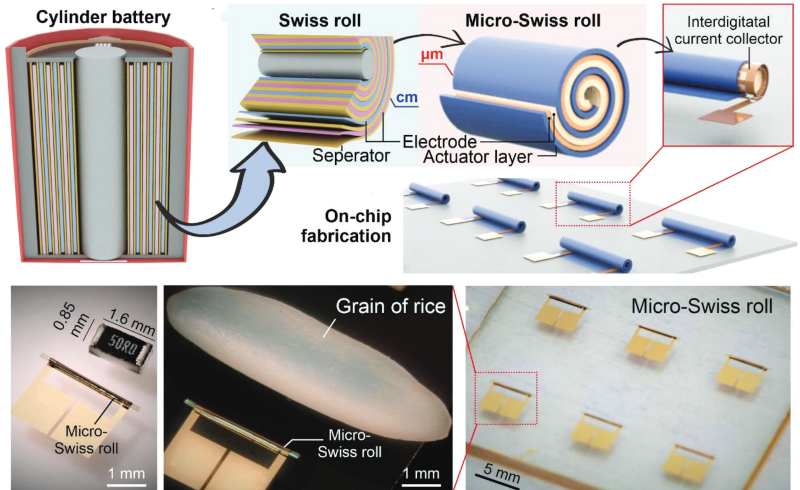Steve Martin had a comedy routine that focused on the idea of “getting small.” That probably didn’t inspire the researchers at the Institute for Integrative Nanoscience when they set out to create a sub-square-millimeter microbattery. As you might expect, you won’t be starting your car with a battery the size of a grain of sand anytime soon, but these batteries do have a surprising capacity.
The key is creating what they call “micro-swiss rolls” where the electrodes are wrapped in a tiny cylinder. This isn’t a new idea. However, creating workable rolls at the scale where a grain of rice looks huge isn’t trivial.
Combining a zinc wire and manganese dioxide in tiny proportions makes the battery possible. The manufacturing process is novel and involves making a slurry of the MnO2 with a solvent. Placing the diminutive swiss roll on a glass substrate allows tiny circuits to exist along side of the battery. The battery itself is about the size of common SMD components, but the circuits it will power are likely more like tiny IC dice.
Building a better battery isn’t a new pursuit, although usually, you aren’t going for tiny. We are always a sucker for novel battery tech, even though most of what we read about never shows up on the store shelves.















>these batteries do have a surprising capacity.
never tells us the capacity
where’s the reporting? May as well just put the link to the paper into a feed and forget the article.
they do mention powering for 5h some low power clock lcd gadget…
I’m not sure these numbers would add any value to the article for the average Hackaday reader, but I might be underestimating the level of knowledge that the average HaD reader has.
Here are two sentances from the paper that might put things into perspective.
“The footprint capacity reaches up to 3.3 mAh cm^-2. 150 stable cycles with a footprint capacity of more than 1 mAh cm^–2 are attainable. This performance outperforms microbatteries with an electrode footprint of less than 10 mm^2 to date.”
“What’s even more noteworthy is that the footprint capacity of the Swiss-roll-based microbattery is almost comparable to the highest attainable footprint capacity to date, which requires a more than 10 times larger footprint (9 mm2 vs 0.75 mm2).”
Strange to mention the capacity per square centimeter and then later use square millimeters to talk about size!
As the battery in question seems to be around 1mm^2 its capacity is 10 to 33 uAh.
It appears to reference mAh per “cm^-2”. I’m no math genius so please correct me if I’m wrong, but isn’t 1^-2 just fancy talk for 1/(1^2), or simplified, 1/4? In this case it’s 3.3mAh per 1/4 of a square centimeter, or 25 mm^2. That gives the battery a capacity of roughly 130 uAh, which seems really small but is great when you consider the scale. I assume this is the case, because 33 uAh wouldn’t be breaking any records anytime soon…
No. cm^-2 just means per square centimeter, no quarters involved, so 3.3mAh.cm^-2 is 3.3 mAh per square centimeter.
What I’m not sure is if this refers to the footprint the cylinder takes or the total area of the rolled up rectangle that makes said cylinder… Assuming the paper is open access I may read it later and find out.
Milliampere-Hour-Level. Right in the title.
For the circuit they implemented, it looks like 6mAh while supplying between 1V and 1V5. The battery did experience a ton of sag under load, about 0.4V once it got more discharged.
Still a really cool technology, and it does look to have potential in well-thought-out low-power embedded applications. The sag and low voltage would just need to be engineering considerations (maybe run two in series to get >1V8?).
Indeed
100 % agreed.. where’s the specs, half of info doesn’t cut..
Is this useable for an RTC? SoC, micro or dedicated?
Also wasnt there anbSMD battery from murrata not to long ago? How do they compare?
this makes no sense, why would you use a micro roll with pads 20 times as big, when you could make a smd sized pouch cell battery with 1/4 the size, and likely more than 10 times the capacity.
That’s just an example usage. This would be useful for smaller items. One possible application would be tiny medical implants, using a MEMS device to charge (or perhaps inductive charging).
According to the scale that is one big grain of rice
Nice observation!
That grain of rice is indeed quite large… I would expect 1mm long, not 1mm radius…
1mm long rice would be ridiculously small, on the order of poppy seed size.
Here’s an example of an application for a similar battery (designed and built at Pacific Northwest National Laboratory)…
New Tiny Battery Powers Big Insight Into Fish Passage for Hydropower
https://www.pnnl.gov/news-media/new-tiny-battery-powers-big-insight-fish-passage-hydropower
Lot of ” smart” people here…. boy how I feel ignorant right now… research…most never goes down production lines( it may cut corporations profits, not duable from them) anyway technology is out there, blocked by most corporations, let’s end globalization and corporate politics. Yes I need to re-educat myself…
What is the difference from other small batteries?